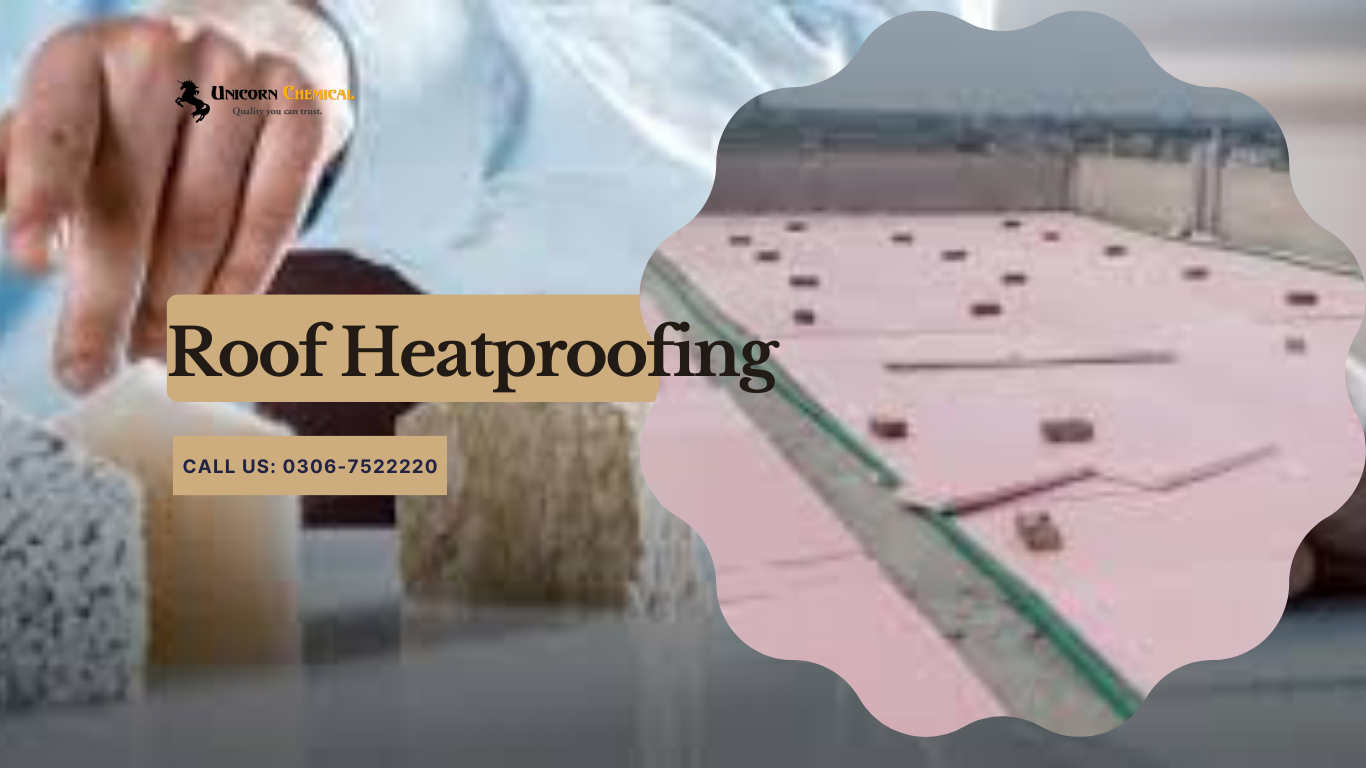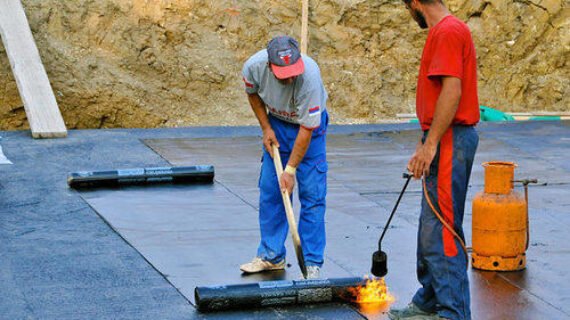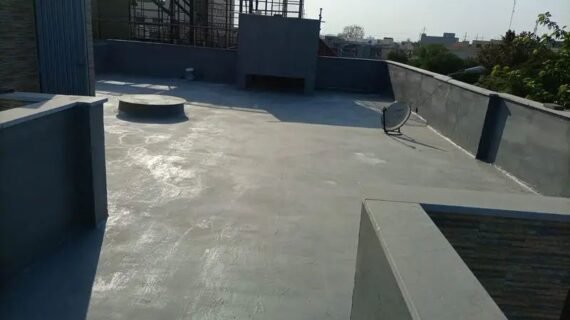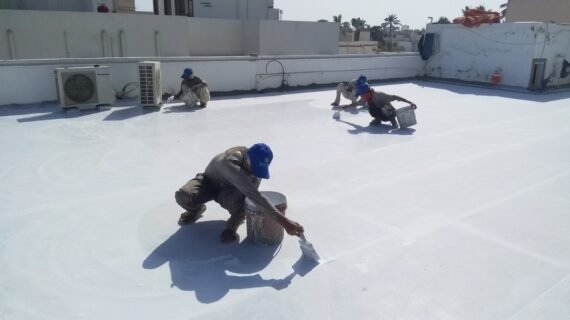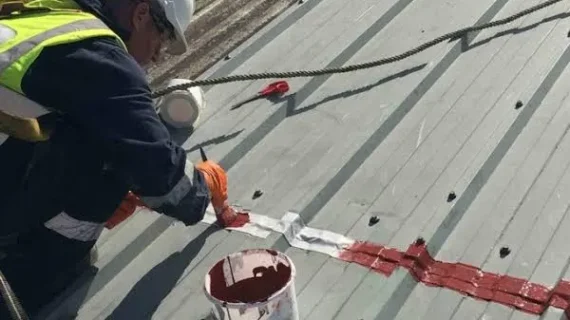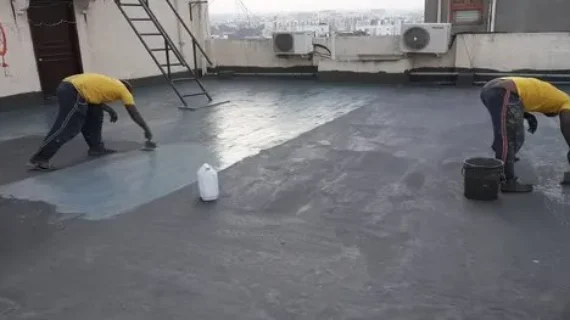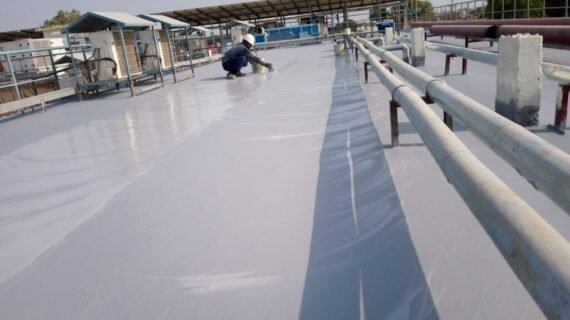Professional Roof Waterproofing Services by Unicorns Chemicals Pvt. Ltd
Comprehensive Guide to Professional Roof Waterproofing Services by Unicorns Chemicals Pvt. Ltd
Unicorns Chemicals Pvt. Ltd, a trusted name in construction chemical services for over 20 years, proudly presents this comprehensive guide on roof waterproofing services. With two decades of excellence, innovation, and dedication, we have become a leading provider of advanced waterproofing solutions for residential, commercial, and industrial buildings across Pakistan and beyond.
What is Roof Waterproofing:
Roof waterproofing is a specialized process designed to make your roof completely resistant to water and moisture penetration. It involves applying a protective layer or treatment that prevents rainwater, humidity, and other moisture-related elements from seeping into the structure. This helps protect not just the roof, but the entire building from serious damage over time.
Why is Roof Waterproofing Important?
Your roof is constantly exposed to harsh weather conditions—sunlight, rain, wind, dust, and temperature fluctuations. Without proper waterproofing, water can easily find its way into cracks, joints, and porous surfaces, causing:
-
Leakages and seepage
-
Mold, mildew, and fungus growth
-
Weakening of structural integrity
-
Paint damage and interior stains
-
Increased repair costs
Waterproofing is a proactive solution, not just a repair strategy. It saves you money in the long term by preventing major damage.
Common Types of Roof Waterproofing Systems
Here are the most widely used roof waterproofing techniques, each designed to suit different types of buildings and budgets:
1. Cementitious Waterproofing
-
Made from cement-based compounds mixed with special additives.
-
Mostly used on rooftops, balconies, bathrooms, and other wet areas.
-
Easy to apply, cost-effective, and ideal for low-risk exposure zones.
2. Liquid Membrane Waterproofing
-
Involves applying a liquid chemical coating (usually polyurethane or acrylic).
-
Dries into a seamless, elastic, and durable membrane.
-
Suitable for flat roofs and areas with complex shapes.
-
Offers UV resistance and long-lasting protection.
3. Bituminous Membrane Waterproofing
-
Utilizes bitumen sheets reinforced with fiber or polyester.
-
Sheets are heat-applied or torch-bonded onto the surface.
-
Excellent for large-scale commercial or industrial roofs.
-
Durable, weather-resistant, and ideal for high-traffic areas.
4. Elastomeric Coating Waterproofing
-
A high-performance flexible coating that stretches and contracts with temperature.
-
Reflects UV rays and reduces heat buildup, enhancing energy efficiency.
-
Often used on concrete and metal roofs.
5. Torch-on Waterproofing
-
Uses modified bitumen sheets applied with a blowtorch.
-
Creates a strong bond and a tough waterproof barrier.
-
Suitable for high-load bearing and heavy exposure areas.
How is Roof Waterproofing Done? (Step-by-Step Process)
Roof waterproofing is a multi-step process that ensures your roof is completely sealed from water infiltration. Here’s a detailed, step-by-step explanation of how professional roof waterproofing is done:
1. Site Inspection and Assessment
The process begins with a thorough site inspection by trained professionals. They evaluate:
-
The type and slope of the roof
-
Visible damage or cracks
-
Existing waterproofing (if any)
-
Moisture content and leak sources
This step helps determine the most suitable waterproofing method and materials.
2. Surface Cleaning and Preparation
Next, the roof surface is cleaned meticulously to remove:
-
Dust, dirt, and loose particles
-
Moss, algae, or mold
-
Old paint or previous coatings
-
Grease or oil stains
Cleaning can be done with pressure washing, wire brushing, or chemical cleaners, depending on the roof condition. A clean surface is crucial for good adhesion of the waterproofing material.
3. Crack and Joint Treatment
Before applying any coating, all cracks, joints, and weak points are sealed using:
-
Polyurethane sealants
-
Cementitious repair compounds
-
Fiber mesh for reinforcement
Expansion joints and drainage areas are given special attention to prevent future seepage.
4. Primer Application (Optional but Recommended)
In many cases, a primer is applied to improve bonding between the surface and the waterproofing membrane. It:
-
Seals micro-pores
-
Increases durability
-
Ensures smooth coating
Priming is particularly important for porous or old concrete surfaces.
5. Application of Waterproofing Membrane or Coating
This is the main step, and the method varies depending on the chosen system:
a. Liquid Waterproofing (Acrylic or Polyurethane)
-
Applied with rollers, brushes, or spray machines
-
Multiple coats are applied in cross directions
-
Drying time is allowed between coats
b. Bituminous Membrane Waterproofing
-
Torch-on technique is used to bond the membrane
-
Membrane rolls are laid across the roof with overlaps
-
Edges and corners are carefully sealed
c. Cementitious Waterproofing
-
Mixed on-site and applied like paint or plaster
-
Needs moist curing for strength and bonding
6. Reinforcement (if needed)
In high-stress areas such as valleys, parapet joints, or drainage outlets, a fiberglass mesh or non-woven fabric is embedded between coating layers for extra strength.
7. Curing and Drying
Once the waterproofing system is applied, it must be cured properly:
-
Curing time ranges from 24 to 72 hours, depending on material
-
No foot traffic or water exposure during this period
-
Ensures complete chemical bonding and elasticity
8. Final Protective Coating (Optional)
A UV-resistant topcoat or solar-reflective paint may be applied to:
-
Protect the waterproof layer from sun damage
-
Extend the system’s life
-
Reduce heat absorption
This layer is especially beneficial for flat roofs in sunny climates.
9. Quality Check and Final Inspection
After curing, a final inspection ensures:
-
No missed spots or pinholes
-
Membrane adhesion is uniform
-
Seepage points are effectively sealed
Water testing may also be done to verify the effectiveness of the waterproofing system.
10. Documentation and Maintenance Plan
Professionals will provide:
-
Warranty or guarantee documents
-
Product data sheets
-
Maintenance recommendations for long-term performance
Routine maintenance, such as clearing drainage outlets and visual inspections every 6–12 months, keeps the waterproofing system in top shape.
-
Signs That Your Roof Needs Waterproofing
Waterproofing your roof is crucial to prevent long-term damage, but many homeowners and building managers ignore the early warning signs—until it’s too late. Identifying these signs early can save you from costly repairs and extend the life of your structure. Here are the most common and critical signs that your roof needs waterproofing:
1. Water Leakage and Seepage
The most obvious sign is visible water leakage from the ceiling or walls. If you notice dripping water during or after rain, it’s a clear indicator that your roof is no longer providing a waterproof barrier.
2. Damp Spots and Water Stains
Brown or yellow water stains on ceilings or upper walls typically mean moisture is entering from above. These stains often spread and darken over time, signaling consistent leakage.
3. Peeling Paint or Wallpaper
Moisture that seeps through the roof often causes paint to bubble, peel, or flake. Wallpaper may start to come loose, especially near the ceiling. This is a telltale sign of water ingress from the roof.
4. Mold, Mildew, and Musty Smells
Persistent dampness leads to the growth of mold and mildew, which can cause musty odors and health issues. Mold typically appears as black, green, or white patches on ceilings, corners, or inside cabinets.
5. Cracks in the Roof or Ceiling
Over time, exposure to moisture can lead to cracks in plaster, concrete, or ceiling boards. Even hairline cracks are pathways for water to seep through and expand the damage.
6. Roof Surface Deterioration
If your roof surface looks worn out, cracked, or blistered, it’s a major sign that the waterproofing membrane is failing. Shingles or tiles that are curled, missing, or broken also indicate underlying waterproofing issues.
7. Ponding or Standing Water
Flat roofs often develop ponds of water after rain. If the water remains for more than 48 hours, it increases the risk of leakage and shows poor drainage or compromised waterproofing.
8. High Indoor Humidity Levels
When your roof is leaking, it raises indoor moisture levels, making rooms feel damp and sticky. This also contributes to faster deterioration of furniture, electronics, and interior finishes.
9. Rusting or Corrosion of Metal Elements
Metal structures or fixtures like gutters, vents, and flashings start to rust or corrode when exposed to constant moisture. This is often due to improper or deteriorated waterproofing around joints.
10. Increased Energy Bills
A leaky roof allows moisture to reduce insulation efficiency, making it harder to maintain a comfortable indoor temperature. This causes higher energy consumption for cooling or heating.
What to Do if You Notice These Signs
If you observe any of the above signs:
-
Don’t delay—schedule a roof inspection immediately
-
Contact a professional waterproofing service provider
-
Opt for a suitable waterproofing solution based on your roof type and damage level
-
Get a preventive maintenance plan to avoid future issues
Common Roof Heat Proofing Service Techniques in Pakistan
With temperatures soaring beyond 45°C in many regions of Pakistan, roof heat proofing has become an essential part of building maintenance. This energy-saving solution not only reduces indoor heat but also increases the lifespan of roofing materials. Here is a comprehensive guide to the most common roof heat proofing techniques in Pakistan, based on local climate, materials, and construction practices.
1. White Reflective Coating (Cool Roof Paint)
Overview:
One of the most widely used methods in Pakistan, white reflective coating (also known as cool roof paint) is an affordable and effective solution for residential, commercial, and industrial roofs.
How It Works:
-
Applied directly on the roof surface
-
Uses UV-reflective polymers or elastomeric acrylics
-
Reflects 80–90% of sunlight, reducing roof surface temperature by 8–15°C
Benefits:
-
Cost-effective
-
Quick to apply
-
Reduces indoor temperature by 5–7°C
-
Saves electricity by lowering AC usage
2. Bitumen Membrane with Heat-Resistant Coating
Overview:
Bitumen-based waterproofing membranes are enhanced with heat-reflective aluminum foil or UV-protective coatings to serve a dual purpose: waterproofing and heat proofing.
How It Works:
-
Torch-applied bituminous sheets
-
Topped with heat-reflective silver or white granules
-
Strong adhesion to concrete, metal, or wood surfaces
Benefits:
-
Long-lasting protection (10+ years)
-
Works in both summer and monsoon seasons
-
Excellent for flat concrete roofs
3. Polyurethane Foam Insulation
Overview:
Widely used in commercial setups, PU foam insulation offers high thermal resistance and strong insulation against heat and cold.
How It Works:
-
Spray-applied foam expands and forms a solid layer
-
Seals cracks, joints, and air gaps
-
Can be coated with elastomeric reflective paint for added UV protection
Benefits:
-
Reduces indoor temperature by 10–15°C
-
Superior energy efficiency
-
Seamless application, no joints or gaps
4. Thermocol Sheets (EPS Panels) with Cement Plaster
Overview:
Expanded Polystyrene (EPS) sheets, commonly known as Thermocol, are laid over roofs and then covered with a cement screed for insulation.
How It Works:
-
EPS sheets placed in interlocking patterns
-
Screed or concrete overlay for protection and stability
Benefits:
-
Affordable
-
Easy to install in both new and old buildings
-
Highly effective in reducing direct heat gain
5. China Mosaic Tiling (Broken Tile Method)
Overview:
A traditional method still practiced in many areas of Pakistan, China mosaic uses broken ceramic tiles fixed with white cement.
How It Works:
-
Reflective ceramic tile fragments are applied in a mosaic pattern
-
White cement grout enhances the reflection
Benefits:
-
Durable and aesthetic
-
Budget-friendly option
-
Reflects sun rays and slows down heat absorption
6. Aluminum-Foil-Based Heat Insulation Sheets
Overview:
Used under roofing sheets or false ceilings, aluminum foil-based insulation works by reflecting radiant heat away from the structure.
How It Works:
-
Sheets made of aluminum foil + air bubble film
-
Installed between roofing materials or under RCC slabs
Benefits:
-
Lightweight and easy to handle
-
Effective for metal roofing and warehouses
-
Reduces heat penetration and improves comfort
7. Hybrid Techniques (Waterproof + Heatproof Coating)
Overview:
Modern hybrid solutions combine elastomeric waterproof coatings with solar reflective pigments, offering dual benefits of leak prevention and thermal insulation.
How It Works:
-
Two-in-one coatings applied over concrete roofs
-
Fills micro-cracks and forms a reflective barrier
Benefits:
-
Ideal for Pakistan’s rainy and hot weather
-
Saves time and money with one-time application
-
Ensures protection for 5–8 years
Choosing the Right Technique:
When selecting a heat proofing technique, consider the following factors:
| Factor | Recommendation |
|---|---|
| Roof type | Flat: Membrane or PU Foam / Sloped: Aluminum Insulation |
| Budget | Low: White Paint / Medium: Mosaic / High: PU Foam |
| Duration | Short-term: Paint / Long-term: Bitumen or Foam |
| Dual Protection | Choose waterproof + heatproof hybrid options |

